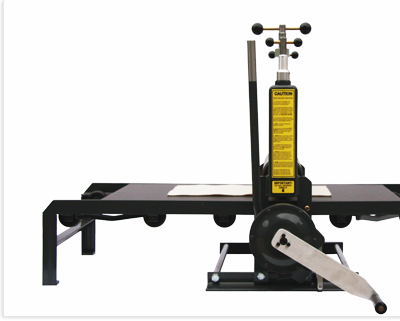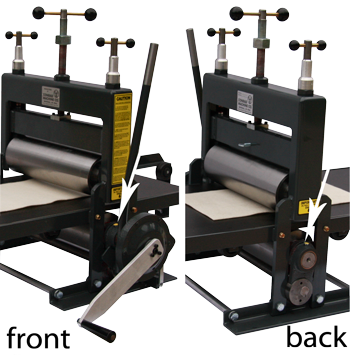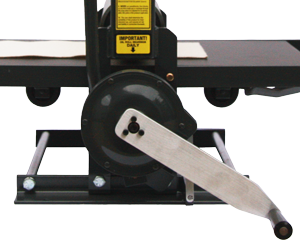
Conrad C-16 Combination Litho-Etching Press Maintenance Manual
Unpacking your C-16 Conrad Combination press.

Your Conrad combination press is shipped on a custom skid/palate and enclosed in a heavy, corrugated box. This box is stapled to the palate using furring strips. If your combination press shipped with an open-spoked star-wheel, Conrad stand/workbench or felt blankets, all of these will be enclosed in the box and attached to the palate. After you remove the star-wheel spokes, stand, and felts the palate and box, you can use a pry-bar or crowbar to remove the stapled furring strips from the palate. After the strips are removed, you can easily lift the box off the palate and press
After your press box is removed, you will see the three items in your box: your press, out-riggers, and bed plate. Your Conrad Combination press and out-riggers are securely bolted to the skid/palate. The out-riggers are also bolted together using tie-rods. The bedplate is securely tied to the frame. First, untie and remove the bedplate from the packaging and place it securely out of harms way. Second, remove the out-rigger tie-rods, so the out-riggers can be separated. Third, unbolt your out-riggers using an adjustable wrench and remove them from the palate. Now your press can be unbolted and removed from the palate.
Setting up your C-16 Conrad Combination press.
Bolting your press down.
Once your Conrad Combination press is unbolted and removed from the shipping palate, your press can be bolted to the Conrad Combination press stand/workbench or another suitable table. The Conrad Combination press stand is custom made to fit your Combination press and provides the optimal support for your press as well as additional space for your inks and other equipment. The C-16 Combination press requires an additional sheet of plywood on top of the press stand prior to press installation. Please see the C-16 stand assembly page for more information. Depending on your press model, either bolt your press directly to your stand or plywood. Please see the Combination stand assembly page for more information about assembling your Conrad Combination stand. If you are not using a Conrad Combination stand, you must allow the drive to hang over the edge of the table to allow the star-wheel to turn.
Installing Combination Press End-frames.
Once your press is bolted down, you can attach the out-riggers with the out-rigger pins. Simply, place the pin on the inside of the press frame and acorn nut on the outside.
Leveling your Combination Press.
Superior press performance and precise printmaking requires a level surface. Place a bubble level across the base angle on both sides of lower roll. If you are using a Conrad Combination stand, leveling your press is quite simple. You can place small shims underneath the feet of the stand until the press frame is level. If you are using an alternative table, you may need to loosen the frame bolts and place small shims under corners of the press frame and end-frames in order to level the frame. To check how level your press end-frames are by placing a level across the ends of frames on both sides. You can now bolt down end frames to the table; however, this is not necessary as long as the main frame is bolted to table.
Installing Combination Press Bedplate
After your Combination press is leveled, you are ready to install the bedplate. Before you move the bedplate, raise the upper roller to allow sufficient room to clear the bedplate. The bedplate safety stops are attached to the bedplate when it ships but are not completely installed. Carefully, remove the one bed stop with instructions attached to it. Place the bedplate on the end frame with the bed stop on top of the bedplate. Carefully, roll the bedplate through the press and follow the instructions for attaching the bed stop. Both bedplate bed stops should be tight and securely bolted to the press bed.
IMPORTANT: Do not operate any Conrad Combination press without properly installed bedplates.
Testing the Bedplate
Once the bedplate and bed stops are installed, you can test the bed by rolling it through the rollers. The bedplate should hit the rollers on the end frame evenly. This is a sign that the press is level. When the bedplate is centered on the lower roller, it should teeter back and forth similar to a teeter-totter. A small amount of teeter is idea for the best printing performance.
Installing an Open spoked Star-Wheel
If your Conrad Combination press has a open spoked star-wheel, you will need to install the spokes once the press is set up. Your Combination press' open spoked star-wheel hub will already be installed on the drive shaft. You will have to install the spokes in the hub. Simply take your spokes and screw them into the star-wheel hub until tight.
Ready to Print
Now your press is all set up and ready to print!
Conrad C-16 Combination Press Maintenance
Your Conrad Combination press requires minimal care and maintenance in order to maintain optimal performance. The most important area of maintenance is oiling and lubrication.
Oiling and Lubricating your Conrad C-16 Combination Press.

Lower Roll Bearing Blocks
The single most important area to be routinely lubricated is the two lower roll bearings. The oil goes into the top of the two bearing blocks and lubricates the roll journals as well as the cam that raises and lowers the lower roll. It is important to drop one to two drops of 30 weight oil into each lower bearing block EVERYDAY to ensure many years of trouble free service.
IMPORTANT: If you do not oil these bearings, you could damage your bearings and cam.

Upper Roller Bearing Blocks
If you are using your combination press as an etching press, you must oil the top bearing blocks at least once a month. Simply, drip three to four drops of 30-weight motor oil in each bearing block oil hole and rotate the roll after the oil is applied.
Geared Drive

The Combination press geared reduction drive is greased at our factory. You should not have to grease your geared drive regularly because it is sealed. You may, however, want to inspect your gear drive every 6 months gear to see that it has a film of grease covering the gears. To check your gear drive, simply remove the pinion and crank assembly. Shine a flashlight in the crank assembly opening to see gears. If the gears appear dry, insert approximately three tablespoons of petroleum-based grease in the opening and replace the pinion and crank. The rotation of the internal parts will distribute the grease to the planet and ring gears.
Pressure Screws
The pressure screws and the upright columns should be kept coated with a light grease applied with a small paint brush to prevent corrosion and to assure smooth operation.
Polishing Rollers
Keep your etching press clean and away from water. Try to keep water from coming into contact with the roller. If your Conrad Monotype press does not have chrome rollers, you may want to keep a light coating of oil on the exposed steel surfaces. You can accomplish this by keeping a tacky cloth, lightly oiled rag, handy. At the end of each day, wipe down the exposed steel surfaces including the rollers. Make sure to wipe off any excess oil on the roller before you begin printing, so the oil doesn't interfere with your printing or stain your felts.
As you use your press, the rollers will gradually become dull and stained. Don't worry; light staining or rusting on the surface is fairly common in humid and will not affect the proper operation of your press. You can clean, polish, and remove discoloration on your press rollers with fine steel wool or "scotch brite" pads. If you are going to store your press for any extended period of time, we recommend putting some type of oil-based preservative on the rollers to keep them from corroding and rusting while in storage.


